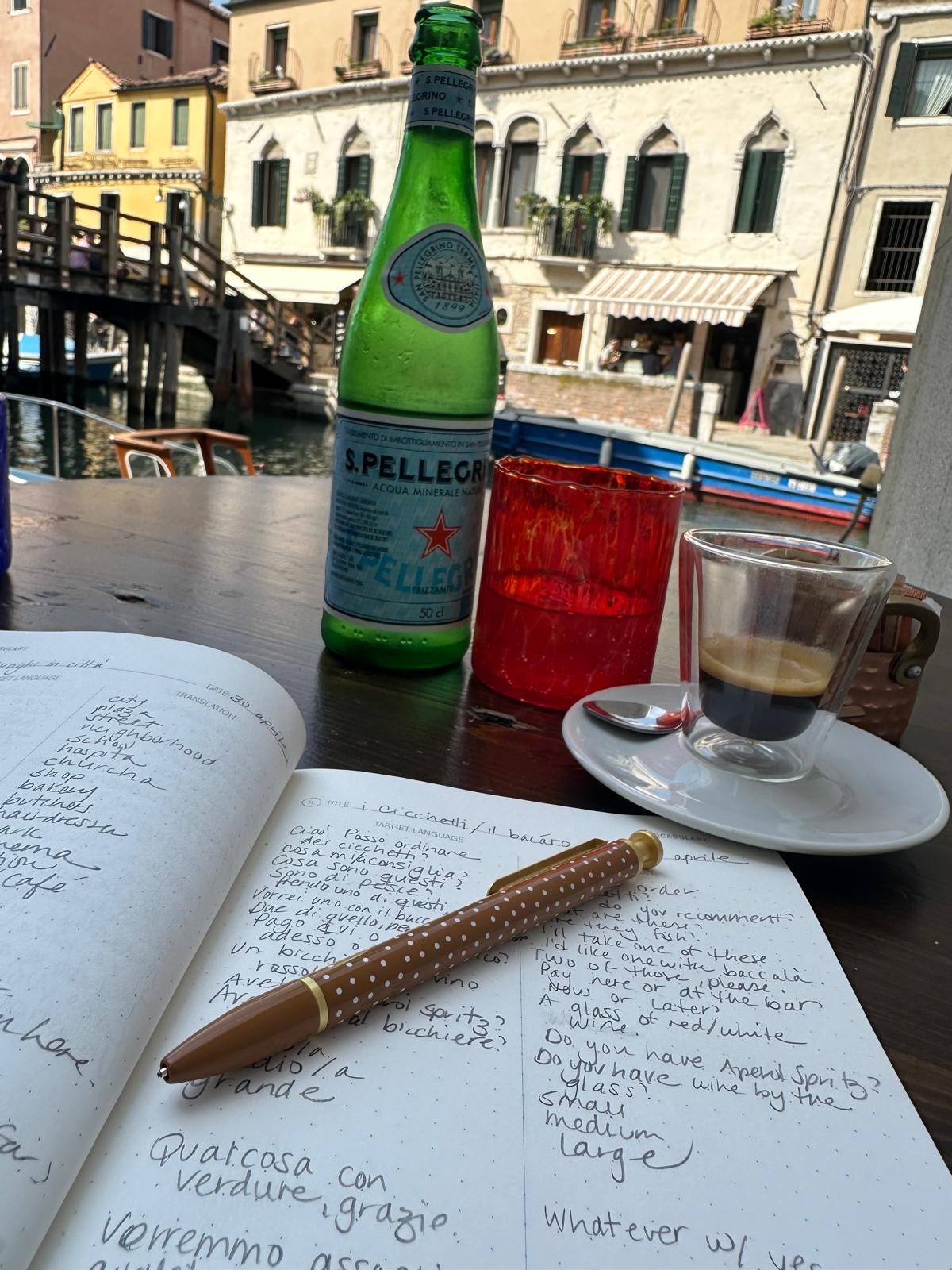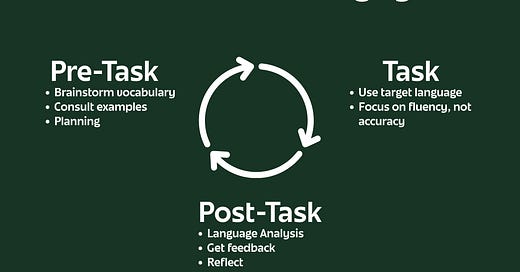I’m back from an incredible work trip to Italy. I won’t write a full travelogue, but the food, the art, the architecture, the lifestyle, and the people were all bellissimo.
This trip gave me the perfect reason to finally start learning some Italian, which I’d been putting off for far too long. I’m so glad I did. I’m also really pleased with how I prepared, so I thought I’d share my approach in case it’s something you’d like to try for your own travels.
Traditional Language Courses vs Traveling Abroad
I’ve written before about some considerations to keep in mind when deciding to take a language course. Here’s something else to keep in mind.
Many traditional courses are designed around grammar points and vocabulary lists. The dialogues, texts and audio tracks aim to simulate real life. The language that’s included in this input has often been carefully graded, so students build confidence and gradually expand their skills. In a classroom, where the main aim is to reach a certain level of fluency or mastery of the language, this structure can work well.

However, this approach may not be suitable for all situations. For example, you might not be interested in mastering a new language but just want to pick up a few phrases to get by. Or maybe, the thought of studying grammar and vocabulary immediately demotivates you. Perhaps you’d rather study on your own or don’t have access to a class, teacher or course book.
If any of these sound like you, you might like to try Task-Based Language Learning.
What is Task-Based Language Learning (TBLL)?
Task-Based Language Learning is an approach that organizes learning around real-world tasks rather than grammar or vocabulary sequences.
Some example tasks include:
Booking a hotel room
Asking for directions
Ordering food at a restaurant
Visiting a doctor
Calling customer service
Completing a job interview
Giving a presentation
In the classroom, the teacher sets up the tasks and students use the target language to complete them. This can take the form of role plays, pair/group activities, classroom discussions and debates, etc.
The focus is not on whether you use the grammar perfectly, but whether you achieve the goal of the task. For example, if your goal is to buy a bus ticket and you succeed, then you’ve communicated effectively, even if your grammar wasn’t perfect.
Benefits of Task-Based Learning
Research has shown that Task-Based Language Learning (TBLL) offers several benefits for adult learners:
Improves speaking fluency and confidence
Learners who practice meaningful tasks tend to speak more confidently and with fewer pauses. Studies show that TBLL is especially helpful for increasing the willingness to speak, which is something many adults struggle with (Yu et al., 2024).Increases vocabulary and grammatical complexity
TBLL encourages learners to use a wider range of vocabulary and more complex grammar, especially when they revisit or plan tasks in advance (Medina Fernández, 2021).Boosts motivation and willingness to communicate
Because tasks are based on real-life situations, learners often feel more engaged. They are not just studying language, but using it to achieve something (Bryfonski & McKay, 2019).Improves listening skills and real-time comprehension
Since many tasks involve live communication, learners become better at understanding and responding in real time (Bryfonski & McKay, 2019).Supports improvement through repetition and reflection
Repeating tasks and reviewing what went well and what was difficult helps learners speak more accurately and naturally over time (Medina Fernández, 2021).
Across many studies, adult learners in TBLL programs perform better in real-world communication and report stronger motivation throughout the learning process.
How do to it
So how does this actually work? Lessons often follow a simple process known as the task cycle. The cycle includes three parts: preparation, completing the task, and reflecting afterward.
Each part has a clear purpose and helps you build confidence, fluency, and awareness of what you can already do and what you want to work on next.
Here’s how it’s organized:
1. Pre-Task (Preparation)
This step helps you get ready for the task by:
Learning or reviewing useful phrases
Brainstorming vocabulary
Listening to a model dialogue or reading a short text
Planning what you might say or write
Example Task: Book a Hotel Room
Watch a short video of someone booking a room. Write down key expressions like:
"Do you have a room for two people?" or "How much is it per night?"
The goal of this stage is to activate what you already know and build confidence before trying the task.
2. Task (The main activity)
This is where you use the language to complete the task.
Some simple rules:
Focus on meaning, not accuracy
Use whatever grammar and vocabulary you can to complete the task
Example Task: Book a Hotel Room
Role play booking a hotel room. One student is the receptionist, the other the hotel guest.
The purpose is to practice using language in context, not to speak perfectly.
3. Post-Task (Reflection and Feedback)
Now that you have done the task, reflect on it.
Ask yourself:
What went well?
What was difficult?
What did I want to say but couldn’t?
What didn’t I understand?
In a classroom environment, the teacher will often give feedback, highlighting mistakes or explaining useful grammar and vocabulary. This is often a focus-on-form stage of the lesson. It may even include some traditional grammar drills or exercises to build automaticity of concepts.
Example Task: Book a Hotel Room
Depending on the errors or gaps in students’ knowledge, the teacher will focus on different elements. For example, perhaps students need help refining pronunciation or need clarification about question formation.
4. Repeat the Task (optional)
After this, you can start the task cycle again. You should try to include modifications from the feedback stage until you feel confident and comfortable with the task.
Sounds simple enough, but what if you don’t have a speaking partner, classmate or teacher to role play with or give you feedback?
You can still follow the task cycle using ChatGPT.
How I used ChatGPT to support TBLL
I have written before about using ChatGPT for French at a B2ish level. The results were mixed. But for beginner-level Italian, I’ve had a much more positive experience. It’s been a useful tool to support my task-based approach to Italian.
Here are some ways you might like to try using it, too:
Pre-Task Preparation
Ask ChatGPT to generate a list of useful phrases for a task like ordering food or booking a hotel room
Use it to create a sample dialogue so you can see how the language is used in context
Task
Role play different situations using voice mode (order a coffee, booking a hotel room, buying a bus ticket, etc.). The beauty of this is that ChatGPT can slightly change its output each time. It’s not like memorizing a dialogue and reading your part. You can ask it to be natural, invent minor problems (e.g. there aren’t any tables) or change the order of each conversation. This will give you more access to language you’re likely to encounter.
Post-Task
This is where ChatGPT falls short. I don’t find it gives me very reliable or useful feedback on my spoken language use. (It can be too encouraging!) However, at this very beginning level, my own reflections are often enough to guide me towards what I need to work on next. I always ask myself:
Where did I get stuck?
What did I try to say but couldn’t?
What did I misunderstand?
Then I go back, review, and repeat the task.
For example, I practiced a restaurant role play with ChatGPT more than fifteen times. Each time I noticed what I didn’t know how to say, which words I forgot, where I got tripped up on pronunciation. I used it to look up those words, go deeper into certain grammar points or rehearse difficult words to pronounce.

I also used ChatGPT as a language sidekick while in Italy. After a challenging conversation or getting confused about the meaning of words, I could gain clarity, take notes and apply my new knowledge to the next conversation.
This approach definitely paid off. I won’t pretend that I can hold a full conversation in Italian. But I did reach my practical goals. I was able to order food and navigate public transport, for the most part. I felt prepared for these situations because I had rehearsed them, slowly, many times. It’s far from a perfect teacher, but it’s a great tool to have in your pocket to prepare for a trip abroad!
Next week, I’ll share a more detailed guide including prompts and a list of tasks you might like to try with ChatGPT. In the meantime, let me know what you think about task-based language learning or about how you like to prepare for a trip abroad!
Thank you so much for reading Love to Lingo.🤍 If you find this newsletter to be a useful tool in your language learning kit, please consider buying me a coffee or restacking this post. I sincerely appreciate your support!
If you haven’t already, I also encourage you to check out the ready-made language learning notebooks I’m selling through Amazon (for now). They’re a simple way to keep your learning organized and motivating.
Happy Language Learning!
References
Bryfonski, L., & McKay, T. H. (2019). TBLT implementation and evaluation: A meta-analysis. Language Teaching Research, 23(5), 603–632.
Medina Fernández, A. (2021). The effects of Task-Based Language Teaching on the Speaking Skill: A systematic research synthesis and meta-analysis. Ciencia Digital, 5(4), 72–93.
Yu, Y., Mofreh, S. A. M., & Salem, S. (2024). Speak Beyond Borders: A Systematic Review of Task-Based Language Teaching for EFL Speaking Proficiency. English Language Teaching, 17(7), 15–27.






Grâce à vous chirstine j’ai commencé écrire sur le subtack après lire votre posture régulièrement qui vous concentrer beaucoup sur l’écriture du journal…merci beaucoup j’ai fait beaucoup des erreurs parce que j’ai sur le niveau avancé a2 et b1 mais j’ai essayé fait mon meilleur
13 years ago when I moved to England, I did not know what was task based language learning. I do indeed hold a precious notebook that will clearly fall into that category. I used to prepare for each task throughly and list answers to any questions I thought I might've got asked.
That was way pre-AI era, when google translate would produce somewhat hilarious translations.
Thank you for this. Definitely task based learning if you need to get conversational pretty quick.